Quick Tip Wednesday: How to Set Up a Gratitude Month
Welcome back to Quick Tip Wednesday!
6 min read
Rebecca Barron : Jun 7, 2025 2:00:00 AM

LINKS FOR YOU
✏️ A Simple Way to Get Elementary Students Writing Every Day - Build writing skills steadily with this easy-to-adapt quick-write strategy that works a little at a time.
🏫 What Can We Do About Chronic Absenteeism? Ask Detroit - Discover how Detroit addresses education's toughest challenges with innovative, research-backed strategies.
🎯 5 Engaging AI Classroom Activities to Try With Your Students - Engage students with AI through creative writing prompts and interactive radio shows.
💙 Why Are Teachers Burned Out but Still in Love With Their Jobs? - Uncover why teachers stay passionate despite workplace stress.
🔍 15 Formative Assessment Hacks to Boost Students' Learning - Supercharge common assessment techniques with simple tweaks that maximize learning impact..
GRANTS FOR PD
🛡️ FY26 Secured School Safety Grant - Funding to support districts with safety officers, assessments, technology, and bullying prevention programs (IN)
🚜 CA FY26 Agricultural Career Technical Education Incentive Grant - Enhance CTE programs to maintain a steady flow of skilled agriculture professionals (CA)
🌐 Title III Limited English Proficient - Grants to help ELLs and immigrant students master language skills while meeting academic standards (AZ)
🎯 Statewide Professional Development to Support the Workforce and Low Incidence Disability Areas FY26 - Build skills and capacity of professionals serving students with low incidence disabilities statewide (MN)
🤝 Learning Communities for School Success Program: Cohort 9 - Support programs that reduce truancy and help at-risk students stay engaged in school (CA)
JOBS
📚 Elementary Teacher (5th Grade ELA/SS) - Shape critical thinking and communication skills in this rewarding fifth-grade position in San Francisco (CA)
⚽ Supervisor of Athletics - Lead athletic programs and foster student development through competitive sports leadership in Paterson (NJ)
🌍 Secondary Social Studies Teacher - Inspire civic engagement and historical thinking in this dynamic teaching role in New Holland (PA)
👩💼 Principal, Elementary (2025-2026 School Year) - Lead and inspire a vibrant school community in this transformational leadership role in San Antonio (TX)
📋 Office Assistant - Saint Louis Park ISD, Saint Louis Park - Support daily operations and create welcoming experiences in this administrative role (MN)
ONE BIG IDEA

Your guide to confidently recognizing warning signs and taking action that makes a difference
The numbers tell a troubling story of what teachers face on a daily basis. Nearly 60% of teens struggle with anxiety or depression, yet only 48% of schools can provide adequate mental health services.
The gap is growing, and as a teacher, you're increasingly the first responder when students are in crisis.
The most commonly identified barriers include insufficient mental health staff coverage and inadequate funding.
Here's the hopeful truth: Early identification by teachers can be life-changing.
Since almost half of lifelong mental health conditions begin by age 14, your awareness and action can connect students with crucial support during the most critical window for intervention.
Spotting mental health concerns isn't always about dramatic behavioral outbursts.
Often, the most significant red flags are subtle shifts that happen gradually over time.
Academic Red Flags
Social and Behavioral Changes
Attendance and Engagement Patterns
The Severity Question
Recognition is only the first step. Here's exactly what to do next.

When you notice concerning patterns, having a clear action plan removes the guesswork and empowers you to respond effectively.
Step 1: Document What You Observe
Keep brief, factual notes about specific behaviors and dates.
This documentation helps school counselors and parents understand the scope and timeline of concerns.
Step 2: Create a Safe Opening
Choose a private moment to check in with the student. Use these conversation starters:
Listen without judgment and avoid trying to solve everything immediately. Sometimes students just need to feel heard by a trusted adult.
Step 3: Know Your Reporting Path
Every school has a protocol for mental health concerns. Typically, this involves:
Step 4: Follow Up Appropriately
After making a referral, continue to be a supportive presence.
Red Alert: When to Call for Help Immediately
Contact administration or emergency services immediately if a student:
Understanding your role versus a counselor's role protects both you and your students while ensuring they get appropriate help.
What IS Your Role:
What ISN'T Your Role:
Legal and Ethical Guidelines
Working with Parents
When mental health concerns arise, parent communication requires sensitivity.
Some parents may be defensive or in denial. Stay factual, express care for the student, and suggest they speak with the school counselor for guidance and resources.
The most powerful mental health support happens through prevention—creating classroom conditions that promote emotional well-being for all students.
Create Psychological Safety
Build Connection and Belonging
Integrate Social-Emotional Learning
Environmental Considerations
Responsive Teaching Strategies When you know a student is struggling with mental health:
You don't need to be a mental health professional to make a profound difference in a struggling student's life. Your awareness, care, and willingness to connect students with appropriate help can be literally life-saving.
Take Action This Week:
Remember Your Impact: Research consistently shows that students who feel connected to adults at school are significantly less likely to experience persistent sadness, hopelessness, or suicidal thoughts. Your classroom may be the safest place some students experience all day.
You're not responsible for fixing every problem or healing every hurt. You are responsible for creating a caring environment, noticing when students struggle, and connecting them with help. That's exactly what great teachers do—and exactly what struggling students need.
The Bottom Line: Mental health awareness isn't an additional burden on your already full plate. It's a lens through which to view the work you're already doing, making you more effective at reaching every student and creating the supportive learning environment where all children can thrive.
Start small, trust your instincts, and remember that your caring attention might be the first step toward getting a student the help that changes their life.

Alludo - we have helped district leaders across the country increase capacity in thousands of schools by successfully delivering millions of evidence-based professional learning lessons to their educators and staff members.
See you next Saturday!
Rebecca
.png)
Welcome back to Quick Tip Wednesday!

Mid-Year Reflection: Your Secret to a Stronger Second Semester
A great way to get your learners engaged in your Alludo program is by keeping the content in your program up-to-date and relevant. Rebecca has...